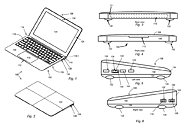- Joined
- Oct 9, 2007
- Messages
- 47,853 (7.39/day)
- Location
- Dublin, Ireland
| System Name | RBMK-1000 |
|---|---|
| Processor | AMD Ryzen 7 5700G |
| Motherboard | Gigabyte B550 AORUS Elite V2 |
| Cooling | DeepCool Gammax L240 V2 |
| Memory | 2x 16GB DDR4-3200 |
| Video Card(s) | Galax RTX 4070 Ti EX |
| Storage | Samsung 990 1TB |
| Display(s) | BenQ 1440p 60 Hz 27-inch |
| Case | Corsair Carbide 100R |
| Audio Device(s) | ASUS SupremeFX S1220A |
| Power Supply | Cooler Master MWE Gold 650W |
| Mouse | ASUS ROG Strix Impact |
| Keyboard | Gamdias Hermes E2 |
| Software | Windows 11 Pro |
Apple wants to hold patents to the wedge-shaped design of its MacBook Air, and an interesting technique to adjust OLED display brightness. The application for this patent passed through USPTO, on Thursday. The application describes claims over "wedge shaped top case", with a lid hinged to a base. The wedge-shape contributes to the user's impression of a device, its lightness, and its durability. Apple's MacBook Air bears this design, and reports indicate that so will the upcoming MacBook Pro series. Wired.com opines that the move is to block out partners of Intel's Ultrabook ecosystem from imitating the design.
Another more interesting patent application for a technique to adjust brightness of OLED displays. None of Apple's products, not even the iPod Nano, feature an OLED screen, yet Apple is frantically applying for the patent. While conventional LCD panels use an augmented illumination source (such as LED or CCFL), in OLED displays, there is no external illumination, and hence adjusting brightness is very tricky from a technical standpoint. The method Apple described in its patent claim consists of converting an image (frame) on a logarithmic scale along the palette, dimming it, and then displaying that dimmed frame. This patent could prove valuable for Apple, as the industry is beginning to transition from TFT-LCD to OLED flat-panel displays.

View at TechPowerUp Main Site
Another more interesting patent application for a technique to adjust brightness of OLED displays. None of Apple's products, not even the iPod Nano, feature an OLED screen, yet Apple is frantically applying for the patent. While conventional LCD panels use an augmented illumination source (such as LED or CCFL), in OLED displays, there is no external illumination, and hence adjusting brightness is very tricky from a technical standpoint. The method Apple described in its patent claim consists of converting an image (frame) on a logarithmic scale along the palette, dimming it, and then displaying that dimmed frame. This patent could prove valuable for Apple, as the industry is beginning to transition from TFT-LCD to OLED flat-panel displays.

View at TechPowerUp Main Site










